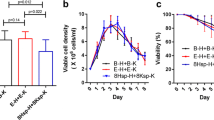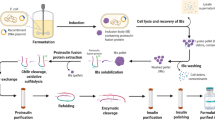Abstract
Human dipeptidylpeptidase IV (hDPPIV) is an enzyme that is in hydrolase class and has various roles in different parts of human body. Its deficiency may cause some disorders in the gastrointestinal, neurologic, endocrinological and immunological systems of humans. In the present study, hDPPIV enzyme was expressed on Spodoptera frugiperda (Sf9) cell lines as a host cell, and the expression of hDPPIV was obtained by a baculoviral expression system. The enzyme production, optimum multiplicity of infection, optimum transfection time, infected and uninfected cell size and cell behavior during transfection were also determined. For maximum hDPPIV (269 mU mL−1) enzyme, optimum multiplicity of infection (MOI) and time were 0.1 and 72 h, respectively. The size of infected cells increased significantly (P < 0.001) after 24 h post infection. The results indicated that Sf9 cell line was applicable to the large scale for hDPPIV expression by using optimized parameters (infection time and MOI) because of its high productivity (4.03 mU m L−1 h−1).









Similar content being viewed by others
References
Aertgeerts K, Ye S, Tennant MG, Kraus ML, Rogers J, Sang BC, Skene RJ, Webb DR, Prasad GS (2004) Crystal structure of human dipeptidyl peptidase IV in complex with a decapeptide reveals details on substrate specificity and tetrahedral intermediate formation. Protein Sci 13:412–421
Bergmann A, Bohuon C (2002) Decrease of serum dipeptidylpeptidase activity in severe sepsis patients: relationship to procalcitonin. Clin Chim Acta 321:123–126
Brondyk W (2009) Selecting an appropriate method for expressing a recombinant protein. Methods Enzymol 463:131–147
Brudnak M (2001) Genomic multi-level nutrient-sensing pathways. Med Hypotheses 56:194–199
Brudnak MA, Rimland B, Kerry RE, Dailey M, Taylor R, Stayton B, Waickman F, Waickman M, Pangborn J, Buchholz I (2002) Enzyme-based therapy for autism spectrum disorders–is it worth another look? Med Hypotheses 58:422–428
Celis JE, Carter N, Simons K, Small JV, Hunter T, Shotton D (2005) Cell biology, four-volume set: a laboratory handbook, vol 1. Elsevier Academic Press, Waltham
Chang MJ, Kuzio J, Blissard GW (1999) Modulation of translational efficiency by contextual nucleotides flanking a baculovirus initiator AUG codon. Virology 259:369
Cunningham DF, O’Connor B (1997) Proline specific peptidases. Biochimica et Biophysica Acta (BBA)—Protein Struct Mol Enzymol 1343(2):160–186
Demuth H, Heins J (1995) Catalytic mechanism of dipeptidyl peptidase IV. Dipeptidyl Peptidase IV (CD26) In: Fleischer B (Ed) Metabolism and the immune response:pp 1–35
Dobers J, Zimmermann-Kordmann M, Leddermann M, Schewe T, Reutter W, Fan H (2002) Expression, purification, and characterization of human dipeptidyl peptidase IV/CD26 in Sf9 insect cells. Protein Expr Purif 25:527–532
Doumas A, Van Den Broek P, Affolter M, Monod M (1998) Characterization of the prolyl dipeptidyl peptidase gene (dppIV) from the koji mold Aspergillus oryzae. Appl Environ Microbiol 64:4809–4815
Effio PC, Folgueras-Flatschart A, Montor W, Pernasetti F, Pueyo M, Sogayar M (2003) Expression of functional Anopheles merusα-amylase in the baculovirus/Spodoptera frugiperda system. Insect Mol Biol 12:415–425
Gotoh T, Fukuhara M, Kikuchi KI (2008) Mathematical model for change in diameter distribution of baculovirus-infected Sf-9 insect cells. Biochem Eng J 40:379–386
Hitchman RB, Possee RD, King LA (2009) Baculovirus expression systems for recombinant protein production in insect cells. Recent Pat Biotechnol 3:46–54
Ikonomou L, Schneider YJ, Agathos S (2003) Insect cell culture for industrial production of recombinant proteins. Appl Microbiol Biotechnol 62:1–20
Iwaki-Egawa S, Watanabe Y, Kikuya Y, Fujimoto Y (1998) Dipeptidyl peptidase IV from human serum: purification, characterization, and N-terminal amino acid sequence. J Biochem 124:428–433
Jalving R, Godefrooij J, Veen WJ, Ooyen AJJ, Schaap PJ (2005) Characterisation of the Aspergillus niger dapB gene, which encodes a novel fungal type IV dipeptidyl aminopeptidase. Mol Genet Genomics 273:319–325
Lambeir AM, Proost P, Scharpé S, Meester ID (2002) A kinetic study of glucagon-like peptide-1 and glucagon-like peptide-2 truncation by dipeptidyl peptidase IV, in vitro. Biochem Pharmacol 64:1753–1756
Langford WS (2003) A comprehensive guide to managing autism. The Autism File. Special Supplement. Slightly changed by Kees de Vries, Drunen, Holland
Luckow V (1991) Cloning and expression of heterologous genes in insect cells with baculovirus vectors. In: Prokop A, Bajpai RK, Ho C (eds) Recombinant DNA technology and applications. McGraw-Hill, New York, pp 97–152
Mentlein R (1999) Dipeptidyl-peptidase IV (CD26)-role in the inactivation of regulatory peptides. Regul Pept 85:9–24
Nishikawa N, Yamaji H, Fukuda H, Dong X, Teruya K, Katakura Y, Zhang Y, Miura T, Daimon Y, Mori T (2003) Preface 1–2 recombinant protein production by the baculovirus–insect cell system in basal media without serum supplementation. Cytotechnology 43:167–168
Ogay I, Lihoradova O, Azimova SS, Abdukarimov A, Slack J, Lynn D (2006) Transfection of insect cell lines using polyethylenimine. Cytotechnology 51:89–98
Öngen G, Sargin S, Üstün Ö, Kutlu C, Yücel M (2012) Dipeptidyl peptidase IV production by solid state fermentation using alternative fungal sources. Turk J Biol 36:665–671
Ota T, Itoh A, Tachi H, Kudoh K, Watanabe T, Yamamoto Y, Tadokoro T, Maekawa A (2005) Synthesis of morphiceptin (Tyr-Pro-Phe-Pro-NH2) by dipeptidyl aminopeptidase IV derived from Aspergillus oryzae. J Agric Food Chem 53:6112–6116
Pérez-Guzmán AE, Cruz y Victoria T, Cruz-Camarillo R, Hernández-Sánchez H (2004) Improvement of fermentation conditions for the production of X-prolyl-dipeptidyl aminopeptidase from Lactococcus lactis. World J Microbiol Biotechnol 20:413–417
Pham PL, Perret S, Doan HC, Cass B, St-Laurent G, Kamen A, Durocher Y (2003) Large-scale transient transfection of serum-free suspension-growing HEK293 EBNA1 cells: peptone additives improve cell growth and transfection efficiency. Biotechnol Bioeng 84:332–342
Radner S, Celie PHN, Fuchs K, Sieghart W, Sixma TK, Stornaiuolo M (2012) Transient transfection coupled to baculovirus infection for rapid protein expression screening in insect cells. J Struct Biol 179:46–55
Reichelt K, Knivsberg A (2003) Can the pathophysiology of autism be explained by the nature of the discovered urine peptides? Nutr Neurosci 6:19–28
Reichelt K, Hole K, Hamberger A, Saelid G, Edminson P, Braestrup C, Lingjaerde O, Ledaal P, Orbeck H (1981) Biologically active peptide-containing fractions in schizophrenia and childhood autism. Adv Biochem Psychopharmacol 28:627
Reinhold D, Goihl A, Wrenger S, Reinhold A, Kühlmann UC, Faust J, Neubert K, Thielitz A, Brocke S, Täger M (2009) Role of dipeptidyl peptidase IV (DP IV)-like enzymes in T lymphocyte activation: investigations in DP IV/CD26-knockout mice. Clin Chem Lab Med 47:268–274
Sander L, Harrysson A (2007) Using cell size kinetics to determine optimal harvest time for Spodoptera frugiperda and Trichoplusia ni BTI-TN-5B1-4 cells infected with a baculovirus expression vector system expressing enhanced green fluorescent protein. Cytotechnology 54:35–48
Sandhu KS, Naciri M, Al-Rubeai M (2007) Prediction of recombinant protein production in an insect cell–baculovirus system using a flow cytometric technique. J Immunol Method 325:104–113
Shattock P, Kennedy A, Rowell F, Berney T (1990) Role of neuropeptides in autism and their relationships with classical neurotransmitters. Brain Dysfunction 3:328–345
Slack JM, Lawrence SD (2002) Purification of DNA for the transfection of a Spodoptera frugiperda cell line. Method Cell Sci 24:155–163
Slack JM, Dougherty EM, Lawrence SD (2001) A study of the Autographa californica multiple nucleopolyhedrovirus ODV envelope protein p74 using a GFP tag. J Gen Virol 82:2279–2287
Summers MD, Smith GE (1987) A manual of methods for baculovirus vectors and insect cell culture procedures. Texas Agricultural Experiment Station Bulletin, No 1555
Tachi H, Ito H, Ichishima E (1992) An X-prolyl dipeptidyl-aminopeptidase from Aspergillus oryzae. Phytochemistry 31:3707–3709
Tanaka T, Camerini D, Seed B, Torimoto Y, Dang N, Kameoka J, Dahlberg H, Schlossman S, Morimoto C (1992) Cloning and functional expression of the T cell activation antigen CD26 [published erratum appears in J Immunol 1993 Mar 1; 150 (5): 2090]. J Immunol 149:481–486
Thoma R, Löffler B, Stihle M, Huber W, Ruf A, Hennig M (2003) Structural basis of proline-specific exopeptidase activity as observed in human dipeptidyl peptidase-IV. Structure 11:947–959
Urade M, Uematsu T, Mima T, Ogura T, Matsuya T (2006) Serum dipeptidyl peptidase (DPP) IV activity in hamster buccal pouch carcinogenesis with 9, 10-dimethyl-1, 2-benzanthracene. J Oral Pathol Med 21:109–112
Üstün Ö, Öngen G (2012) Production and separation of dipeptidyl peptidase IV from Lactococcus lactis: scale up for industrial production. Bioprocess Biosyst Eng 35(8):1417–1427
Wilkinson RE, Houston DB (2001) Compositions containing dipepitidyl peptidase IV and tyrosinase or phenylalaninase for reducing opioid-related symptons. U.S. Patent No 6,251,391. U.S. Patent and Trademark Office, Washington, DC
Acknowledgments
This research was partly supported by grant from Japan Student Service Organization (JASSO).
Author information
Authors and Affiliations
Corresponding author
Rights and permissions
About this article
Cite this article
Üstün-Aytekin, Ö., Gürhan, İ.D., Ohura, K. et al. Monitoring of the effects of transfection with baculovirus on Sf9 cell line and expression of human dipeptidyl peptidase IV. Cytotechnology 66, 159–168 (2014). https://doi.org/10.1007/s10616-013-9549-3
Received:
Accepted:
Published:
Issue Date:
DOI: https://doi.org/10.1007/s10616-013-9549-3




